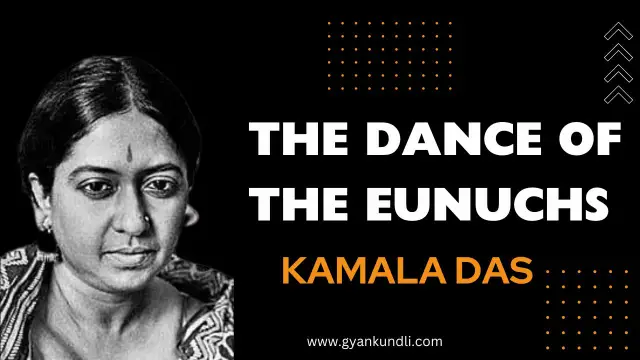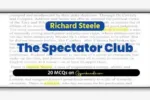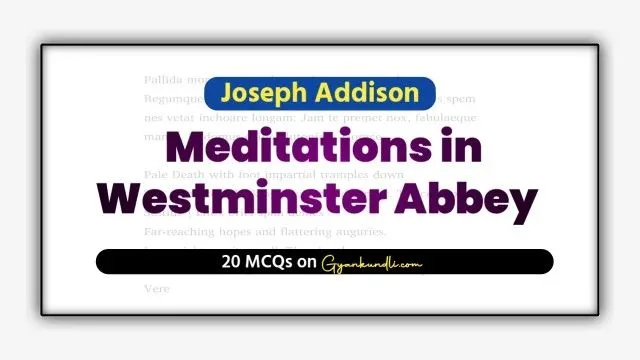Introduction
The Dance of the Eunuchs is considered as one of Kamala Das’s best poems. This poem appeared in Summer in Calcutta. It’s the first poem in the collection, setting the tone for all the poems. The poem strongly conveys Kamala Das’s feelings using well-chosen words and repeated phrases. There’s a lot of vivid imagery, and the overall mood of the poem is gloomy.
The poem reflects the poet’s experiences and sympathy for eunuchs. The costumes, makeup, and passionate dance suggest femininity, but underneath, there’s inner sadness expressed through harsh songs about dying lovers and unborn children. Despite their outward appearance, the eunuchs lack joy and can’t dream of happiness due to their fractured personality. The background of thunder, lightning, and meager rainfall mirrors their outward sparkle and inner emptiness. The dance of the eunuchs symbolizes Kamala Das’s unfulfilled love.
Life and works of Kamala Das
Kamala Das, also known as Madhavikuti, was born in Malabar in 1934. She received her education at home and in schools in Bengal and Kerala. Coming from a family of writers, her mother, Padma Bhushan Nalapat Balamani Amma, was a famous Malayalam poet, and her father was the editor and Managing Director of Mathrubhumi, a leading Malayalam newspaper. At the age of fifteen, she married K. Madhava Das, who later became an R.B.I. Officer.
Kamala Das started writing poetry at the age of six, with her first poem published in P.E.N. India at fourteen, edited by Sophia Wadia. Her poetry gained recognition when she received the Asian Poetry Prize from P.E.N. Philippines in 1963. She served as the poetry editor of The Illustrated Weekly of India from 1971 to 72 and again from 1978 to 79. Her works appeared in various publications, including Opinion, New Writing in India, and Young Commonwealth Poets.
Kamala Das was a versatile writer, excelling in essays, fiction, short stories, criticism, and journalistic features in both Malayalam and English. Her noteworthy works include seven volumes of poetry, two novels (“Manas” and “The Alphabet of Lust“), a collection of short fictions (“A Doll for the Child Prostitute“), and an autobiography titled “My Story.” Some of her well-known books are “Summer in Calcutta” (1965), “The Descendants” (1967), and “The Old Playhouse and Other Stories” (1973). Her Collected Poems, Volume 1, published in 1984, earned her the Sahitya Akademi Award in 1985. Another collection, “The Soul Knows How to Sing: Selections From Kamala Das,” was published in 1997.
Text of the Dance of the Eunuchs
It was hot, so hot, before the eunuchs came
To dance, wide skirts going round and round, cymbals
Richly clashing, and anklets jingling, jingling
Jingling… Beneath the fiery gulmohur, with
Long braids flying, dark eyes flashing, they danced and
They dance, oh, they danced till they bled… There were green
Tattoos on their cheeks, jasmines in their hair, some
Were dark and some were almost fair. Their voices
Were harsh, their songs melancholy; they sang of
Lovers dying and or children left unborn….
Some beat their drums; others beat their sorry breasts
And wailed, and writhed in vacant ecstasy.
TheyWere thin in limbs and dry; like half-burnt logs from
Funeral pyres, a drought and a rottennessWere in each of them.
Even the crows were soSilent on trees, and the children wide-eyed, still;
All were watching these poor creatures’ convulsions
The sky crackled then, thunder came, and lightning
And rain, a meagre rain that smelt of dust in
Attics and the urine of lizards and mice…
Analysis of The Dance of the Eunuchs
In “The Dance of the Eunuchs,” there are two levels of meaning. On the surface, the poet seems to feel for the eunuchs who are compelled to dance in the scorching sun, dancing until they bleed. Their “harsh” voices and “melancholy” songs about dying lovers and unborn children become evident. Comparing the eunuch’s “thin and dry body” to a half-burnt log evokes shock and pity, creating a dramatic scene without inner vitality.
On another level, written in a confessional style, the poem symbolically reflects the poet’s sadness in her own life. The eunuchs symbolize unproductiveness and barrenness. For Kamala Das, the poem becomes an objective representation of her inner suffering. The dance of the eunuchs, with skirts swirling and cymbals clashing, is contrasted with their “vacant ecstasy,” highlighting the gap between outward passion and inner emptiness. This contrast continues throughout the poem, portraying the eunuch’s dance as that of the sterile, compared to the unfulfilled love in the poet’s life.
The poem skillfully uses images and symbols to portray the summer season, emphasizing the hot weather with words like ‘so hot‘ and ‘fiery‘ before gulmohar. Colors such as green, jasmine, dark, and fair vividly depict the external beauty of the eunuchs, contrasting with the emptiness inside, described as ‘vacant ecstasy,’ ‘thin and dry like half-burnt funeral pyres,’ and ‘drought and rottenness.’
Words like ‘crackled,’ ‘thunder,’ ‘lightning,’ and ‘rain‘ create the atmosphere of the rainy season, representing a natural shift from hot summer. The title’s meaning is not straightforward; the eunuchs’ dance, while associated with them, is a livelihood and compulsion rather than an expression of inner joy, making it an antithesis reflecting their unhappiness.
The poem, narrated in the third person, captures the dance’s atmosphere through descriptions of eunuchs’ dress and behavior. The rhythm of the dance intensifies throughout the poem, reaching a climax with thunder, lightning, and rain. However, there’s a sudden fall in rhythm in the last two lines, reflecting the poet’s depressed state and a sense of futility in her sexual experience.
Read this also : The-dance-of-the-eunuchs-questions-and-answers
Discover more from Gyankundli
Subscribe to get the latest posts sent to your email.
















2 thoughts on “The Dance of the Eunuchs by Kamala Das : Analysis”